1335 WAS THE LAST DATE FOR THE FULFILLMENT OF THE "PROPHECY" OF JOACHIM OF FIORE FOR A UNIVERSAL MUSLIM CALIPHATE....TO HELP FULFILL THAT "PROPHECY," THE PAPACY ABANDONED ROMA AND MOVED TO AVIGNON IN 1309. |
Amazingly, there were 7 kings in the Romulus dynasty before the Romans discovered that kings were a disaster and they banned them forever.
| European population before Avignon | European population after Avignon |
|---|---|
| 80,000,000 | 30,000,000 |
Here is a quote from a Europe-wide demographic study of the Black Death:
If these data are representative of the Black Death's ravages elsewhere in Europe, and Europe's population at that time was around 80 million persons, as commonly believed, 50 million of them died in the Black Death. This is a truly mind-boggling, horrifying, and unnerving result to all persons with their elementary sensibilities intact. It overshadows the horrors of the Second World War, and it is twice as many persons as were murdered by Stalin's regime in the Soviet Union. (Benedictow, The Black Death 1346–1353).
By the beginning of the 14th century the Man of Sin had grown to his full statue and he stood astride the earth like a colossus. His thunderbolts made kings tremble on their thrones and every ruler in Europe feared his Interdict and Excommunication.
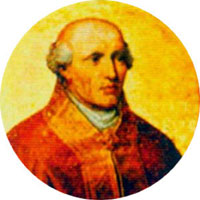 Pope Boniface VIII (1230–1303). Reigned from 1294 to 1303. |
|
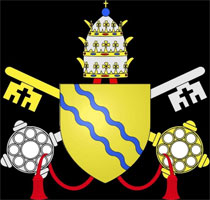 Boniface VIII coat of arms with the keys of Romulus and Remus. |
As a capstone on the gigantic pyramid of error that began in the 4th century, Pope Boniface VIII issued a Bull which declared that every human being on the earth was subject to the Papal monarch:
Furthermore, we declare, we proclaim, we define that it is absolutely necessary for salvation that every human creature be subject to the Roman Pontiff. (Unum Sanctum, November 18, 1302).
Alarmingly, millions of people still believe that Dark Ages dogma today!
Italian writer Dante Alghieri, in his Divine Comedy, placed Boniface in the Eighth Circle of Hades, among the simoniacs. Boniface canonized King Louis IX of France—the grandfather of King Philip IV, and the only French king to be made a Papal saint.
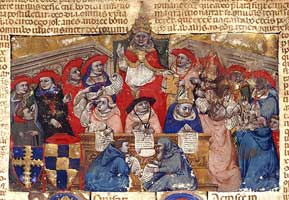 A joyful Pope Boniface and his College of Cardinals counting the cash from the Jubilee Year. |
|
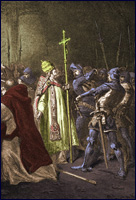 Sciarra Colonna (1270–1329) slapping Pope Boniface. |
A joyful Pope and College of Cardinals counting the money from the Jubilee Year.
For centuries, Avignon was the property of the Papacy. During the French Revolution it became part of France. The town is now the capital of the Vaucluse department and one of the few French cities to have preserved its ramparts.
 Provence is now located in south-eastern France. |
|
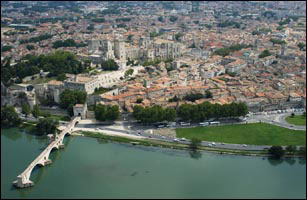 Contemporary view of Avignon, France. Contemporary view of Avignon, France. |
The reign of Boniface was followed by the brief reign of Pope Benedict XI which only lasted 8 months.
Clement V was the FIRST Avignon Pope
Raymond Bertrand de Got, the man who became known as Pope Clement V, was the first Avignon Pope.
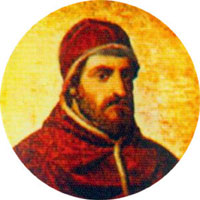 Pope Clement V (1264–1314). Reigned from 1305 to 1314. |
|
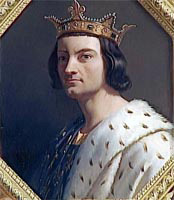 King Philip IV (1268–1314). King from 1285 to 1314. |
The Knights Templar had a stranglehold on the economy of France and they were the bankers for the entire Western world:
The combination of armed strength and vast landed wealth led unerringly to a further role for the knights: they became unrivalled in being able to transport money and precious goods safely from one city to another-a priceless asset in an unstable world. As a result they rapidly became bankers, earning a reputation for financial acumen. They soon came to manage the finances of monarchs, including (again ironically, in view of their future fate) the kings of France. Their temple in Paris was in everything but name the Western world's bank. This was the pinnacle of their power. (Mullins, The Popes of Avignon, pp. 27-28).
King Philip IV acted secretly and decisively and he ordered the arrest of the Knights Templar on Friday, October 13, 1307. When Catholics start "persecuting" Catholics it is time to smell a big RAT.
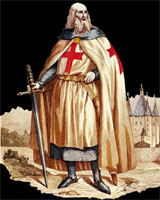 Jacques de Molay (1243–1314) became a Templar "martyr." |
|
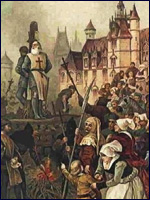 Burning of Jacques de Molay and Geoffrois de Charnay at the stake. |
The suppression of the Jesuits by Pope Clement XIV in 1773 did not abolish the Society of Jesus. They just went underground and emerged a lot stronger. Neither did the brutal suppression of the Templars lead to their abolition. The founded the ultra-secret country of Switzerland which became the ultimate Papal state.
John XXII was the SECOND Avignon Pope
During the pontificate of John XXII, a desperate struggle ensued for control of Roma. Louis IX of Bavaria entered the city in January 1328, and was crowned Emperor by senator Sciarra Colonna.
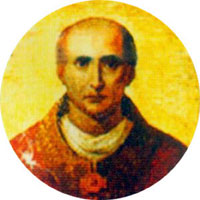 Pope John XXII (1244–1224). Reigned from 1316 to 1334. |
|
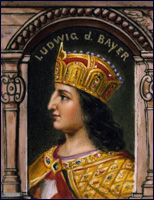 Louis IV of Bavaria (1282–1347). |
Louis was threatened by the king of Naples, so he withdrew from Roma in August 1328. Pope John has also the dubious distinction of canonizing "Dumb Ox" Thomas Aquinas.
Benedict XII was the THIRD Avignon Pope
The next Pope in the Papal museum Chamber of Horrors was a Cistercian monk named Jacques Fournier. Fournier ran the Inquisition before his became Pope and he delighted in the torture and burnings of Christians. So zealous was he at exterminating the disciples of Christ, that the monk was fast tracked to the Avignon Papacy.
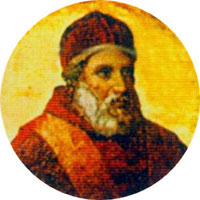 Pope Benedict XII (1285–1342). Reigned from 1334 to 1342. |
|
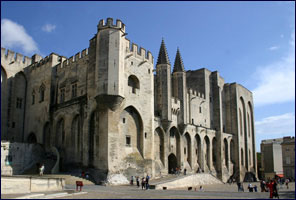 The massive Palace of the Popes at Avignon. |
Here is a quote on his feverish building activity:
Construction work itself began a little more than a year after the new pope took office. The first area to be completed was a fortified tower more than one hundred and fifty feet tall. This had a dual purpose: the lower part of the tower came to house the papal treasury, including the most important official documents, while the upper floors became the papal apartments. These were essentially modest, as befitted a former Cistercian; in fact Benedict insisted on wearing his monk's habit throughout his papacy except on ceremonial occasions. (Mullins, The Popes of Avignon, p. 73).
All the pontiffs HATED their new location but they knew that the door to Roma was permanently barred to them.
Clement VI was the FOURTH and Black Death Avignon Pope
Benedictine monk Pierre Roger needs no introduction. He was the infamous Black Death Pope who unleashed Bubonic Plague on Europe. Clement knew that the Italian people—and especially the Romans—did not want the Papacy ever to return to the city of the Caesars.
 Pope Clement VI (1291–1352). Reigned from 1342 to 1352. |
|
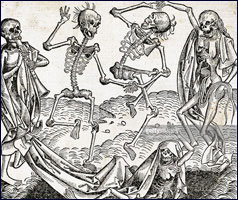 Most of Europe was doing the Dance of Death in 1348 and '49. |
Here is a brief quote about the Black Death from a pro-Catholic French historian:
The festivities for which his court provided the setting did not make Clement VI unmindful of his duties as pontiff. He took pleasure in presiding at religious ceremonies, in preaching to the people and making speeches in memorable circumstances. His charity was boundless when the Black Death depopulated Europe in 1348 and again in 1349. This sickness had come from China by three different routes: by India, the Caspian Sea and Asia Minor; by Bokhara, Tartary and Constantinople; and by Baghdad, Arabia, Egypt, and Africa. It was introduced into Italy by vessels which had put into the islands of the Archipelago, it devastated Florence, crossed the Alps, attacked France and gained a hold in Belgium, Holland, England, Denmark, Sweden and Norway, and as far as Iceland and Greenland. It is estimated that about forty million people died in this horrible epidemic (Mollat, The Popes at Avigon, pp. 39-40).
The Black Death did not come from China, or the Far East. It came from the local Benedictine, Franciscan, and Dominican monasteries, and was spread by the monks poisoning the drinking water.
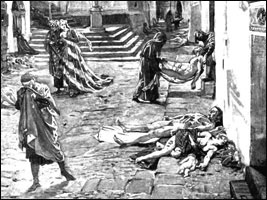 A typical Black Death scene in Italy and France. |
|
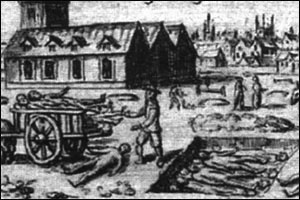 Typical burial scene during the Black Death. |
The plague did not distinguish between Christians and Catholics so all were dumped into huge mass graves.The greatest death toll took place in the former Papal territories:
The year 1348 signaled the first onslaught of the plague in the papal territories. But it was not the last. Two further outbreaks occurred during the remaining thirty years of the Avignon papacy—in 1361, then in 1368, each time killing between ten and twenty percent of the already devastated population. By the end of the century the population of the whole of Europe was barely half of what it had been fifty years earlier. (Mullins, The Popes of Avignon, pp. 125-126).
All the Popes knew that the only way they were going to ever return to Roma was to eliminate an entire generation.
"Innocent" VI was the FIFTH Avignon Pope
After Clement joined all the other millions of victims of the Black Death, Étienne Aubert was appointed the next Pope. He took the name "Innocent" VI.
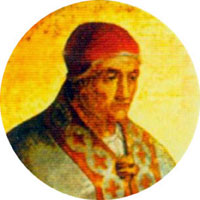 Pope "Innocent" VI (1282–1362). Reigned from 1352 to 1362. |
|
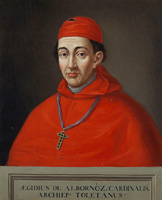 Gil Alvarez de Albornoz (1310–1367). |
Here is a quote from a history of the Avignon Popes:
The soldier-cardinal duly left Avignon in August 1353, in the first year of Innocent's pontificate, and his military operation began that December against the rebel states in central Italy. Albornoz immediately displayed his diplomatic skills by securing the support—surprisingly—of that sworn enemy of Avignon, Giovanni Visconti, the ruler of Milan. (Mullins, The Popes of Avignon, p. 170).
Even though Labornoz waged deadly warfare on the now devastated population, he was not able to secure control of Roma, and thus Pope Clement's fondest wish of returning to the city of the Seven Hills could not be fulfilled.
Urban V was the SIXTH Avignon Pope
Benedictine monk Guillaume de Grimoard, who took the name Urban V, was the sixth Avignon Pope.
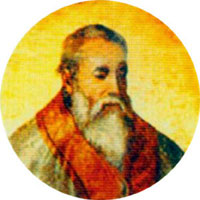 Pope Urban V (1310–1370). Reigned from 1362 to 1370. |
|
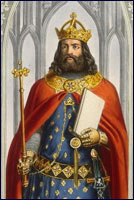 Emperor Charles IV (1316–1378). |
Plantagenet King Edward III was vitally interested in restoring the Popes to the city of the Seven Hills. His secret agent in Italy was named Sir John Hawkwood.
 Sir John Hawkwood (1323–1394). |
|
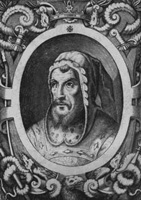 Barnabo Visconti (1323–1385). |
After his return to Avignon on September 24, 1370, Urban fell ill and died suddenly. Obviously, just another case of poisoning.
Gregory XI was the SEVENTH Avignon Pope
Pierre Roger de Beaufort was the seventh and last Avignon Pope. He took the name Gregory XI.
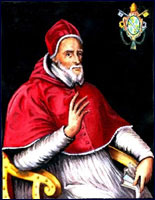 Pope Gregory XI (1329–1378). Reigned from 1370 to 1379. |
|
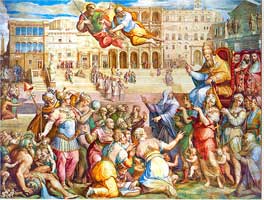 Catherine of Siena leading Pope Gregory back to Roma. |
It was "dead head" Catherine of Siena who shamed Gregory into returned to Roma:
Historians have long been divided on what finally drove Pope Gregory to make the long-promised departure to Rome. Some have balked at the idea that his decision might have resulted from the blandishments of a woman; nonetheless there can be no denying that the arrival in Avignon of a steely self-assured lady from Italy did coincide with the ending of the pope's long procrastination. She was a young Dominican laywoman by the name of Catherine Benincasa, later to be canonized as St. Catherine of Siena and to become patron saint of Italy. (Mullins, The Popes of Avignon, p. 207).
Evil twin Catherine of Siena is the person most responsible for returning the Papacy to Italy.
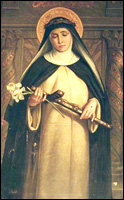 Catherine of Siena (1347–1380). |
|
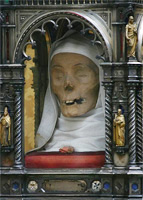 The "dead head" of Catherine is on display at the Basilica of San Dominico. |
It was a woman, Queen Joanna of Naples, who sold Avignon to Pope Clement twenty-eight years earlier. Now it was another woman who led Gregory—like an ox to the slaughter—back to Roma.